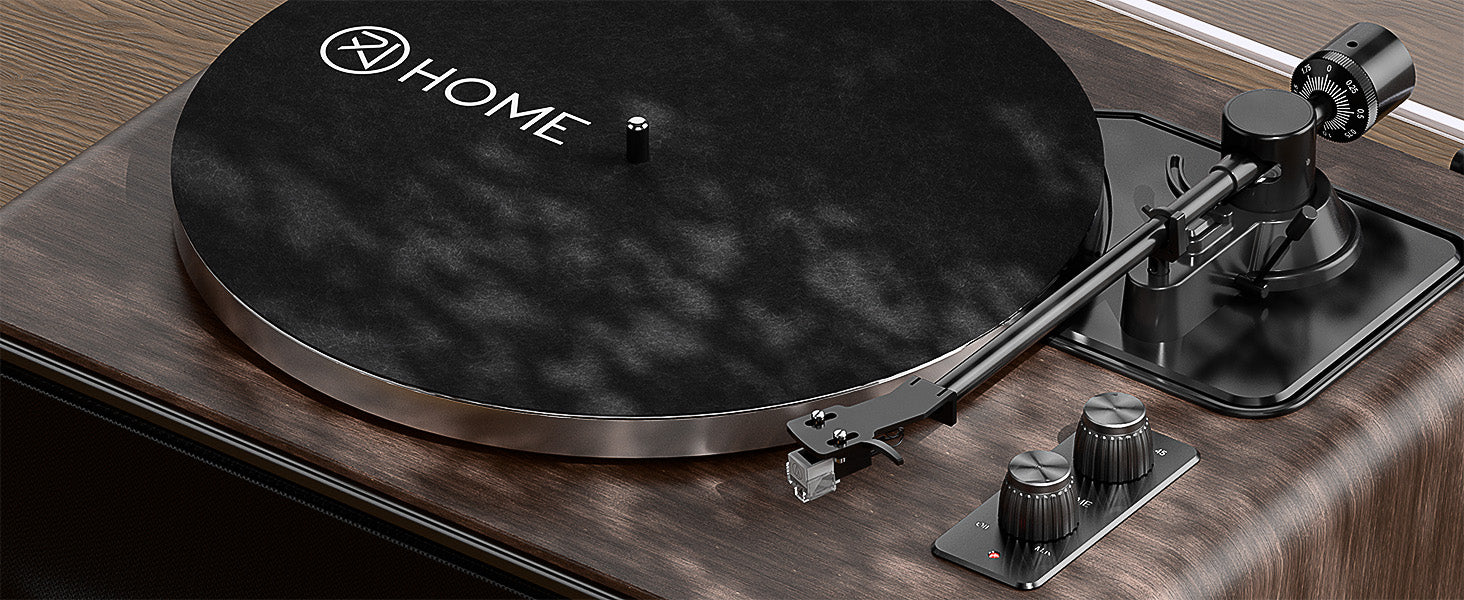The allure of vinyl is undeniable. In an increasingly digital world, the tactile experience of selecting a record, the gentle drop of the stylus, and the warm, immersive sound offer a connection to music that’s both profound and deeply personal. If you're reading this, you're likely on the cusp of starting or expanding your own vinyl collection – an exciting prospect! But with that excitement comes a crucial first step: choosing your turntable. Get this right, and you're paving the way for years of analog bliss. Get it wrong, and you risk damaging your records and a listening experience that falls flat.
This isn't just about finding the "cheapest" option. It's about finding value and a foundation for genuine audiophile enjoyment. We're going beyond superficial lists to explore what truly constitutes a great entry-level record player in 2025.
What "Entry-Level" Should Mean (And What It Absolutely Shouldn't)
Let's be iconoclastic for a moment. The market is flooded with ultra-cheap, all-in-one "suitcase" record players that promise vintage charm. The hard truth? Most of these are, frankly, detrimental to your records and your listening pleasure. They often feature:
-
Non-adjustable tonearms: With tracking forces that are far too heavy, literally grinding away at your vinyl grooves with each play.
-
Low-quality ceramic cartridges: Offering poor sound fidelity and further contributing to record wear.
-
Flimsy platters and weak motors: Leading to unstable speeds (hello, wobbly pitch!) and excessive vibration.
-
Tiny, poor-quality built-in speakers: Delivering a sound that’s a pale imitation of what vinyl can offer.
The human desire for an easy, affordable entry point is understandable. But the practical reality is that these players often become a fast track to disappointment and damaged LPs. A true entry-level audiophile turntable, even on a budget, should be built on principles of decent sound reproduction and, critically, respect for the physical medium. It should be a starting point, not a dead end.
The Non-Negotiables: Core Features Your First Turntable Must Have
To avoid buyer's remorse and ensure your records sing (and survive), look for these foundational features:
-
Adjustable Tonearm (Counterweight & Anti-Skate): This is paramount.
-
Counterweight: Allows you to set the correct Vertical Tracking Force (VTF) for your specific cartridge. Too light, and the stylus mistracks, causing distortion and skipping. Too heavy, and it gouges your grooves.
-
Anti-Skate: As the stylus tracks across the record, a natural inward force pulls the tonearm. Anti-skate applies a gentle outward counter-force, keeping the stylus centered in the groove for balanced sound and even wear.
Without these adjustments, you're flying blind and likely harming your records.
-
-
Decent Quality, Replaceable Moving Magnet (MM) Cartridge & Stylus:
-
Avoid ceramic cartridges like the plague. A Moving Magnet (MM) cartridge is the standard for quality entry-level and mid-range turntables. It offers far superior sound fidelity and is much kinder to your vinyl.
-
The ability to replace the stylus (the needle itself) is essential, as styli wear out over time. Being able to upgrade the entire cartridge later is a huge bonus for future sound improvements.
-
-
Solid Plinth (Base) and Platter:
-
The plinth should be dense and well-damped to minimize vibrations from the motor and the environment.
-
The platter (what the record sits on) should be substantial enough to provide good speed stability and further reduce resonance. Materials like aluminum, steel, or even acrylic (on higher-end entry-level models) are preferable to thin plastic.
-
-
(Highly Recommended) A Defeatable or Quality Built-in Phono Preamplifier:
-
Turntables produce a very low-level "phono" signal that needs to be boosted and equalized (via the RIAA curve) before an amplifier can process it. This is the job of a phono preamplifier (or phono stage). For a deep dive into what phono preamps do and why they're essential, check out a comprehensive guide like the one on Crutchfield's website.
-
Many entry-level turntables include a built-in phono preamp, which is incredibly convenient for beginners as it allows direct connection to powered speakers or any amplifier with a standard line-level input (like AUX).
-
The ideal scenario is a built-in preamp that can be switched off (defeated). This gives you the option to upgrade to a higher-quality external phono stage later, a common and impactful upgrade path for audiophiles.
-
Navigating the Options: Key Considerations & Trade-offs
-
Manual vs. Automatic Operation:
-
Manual: You lift the tonearm, place it on the record, and lift it off at the end. Purists often prefer manual for its simplicity and potential for better sound quality (fewer mechanisms to introduce noise).
-
Automatic/Semi-Automatic: The tonearm automatically starts play and/or returns at the end of the record. Convenient, especially for newcomers, but can sometimes mean more complexity and a slight compromise in ultimate fidelity at the very low end.
-
-
Belt Drive vs. Direct Drive:
-
Belt Drive: The motor is offset and connected to the platter via a belt. This design helps isolate motor vibration from the platter and stylus, generally favored for audiophile listening. Most recommended entry-level tables are belt-drive.
-
Direct Drive: The platter sits directly on the motor spindle. Offers quick start-up and very stable speed, favored by DJs. Some excellent direct-drive hi-fi turntables exist (like some Audio-Technica models).
-
-
Connectivity (Bluetooth, USB):
-
Bluetooth: Allows wireless streaming to Bluetooth speakers or headphones. Convenient, but be aware that the audio signal is digitized and compressed, so it's not the purest vinyl experience.
-
USB: Allows you to connect the turntable to a computer to digitize your vinyl collection. A niche feature for some.
These are nice-to-haves but should be secondary to core audio quality and record care features.
-
Spotlight on Recommended Entry-Level Turntables (Circa 2025)
Based on consistent reviews, feature sets that align with our "non-negotiables," and overall value, here are a few standout models for new collectors in 2025. (Prices are approximate and can vary.)
-
Fluance RT82 ($300):
-
Why it's a great start: The RT82 frequently hits the sweet spot for price-to-performance. It offers a solid build, all the essential adjustments, and a clear upgrade path within the Fluance family.
-
Key Features: Ortofon OM10 cartridge (a well-regarded entry-level audiophile cartridge), adjustable counterweight and anti-skate, aluminum platter, auto-stop feature, solid MDF wood plinth. It does not have a built-in phono preamp, so you'll need an external one or an amplifier with a phono input.
-
Considerations: The lack of a built-in preamp means an extra component to budget for if your current amp doesn't have a phono input.
-
-
Audio-Technica AT-LPW40WN ($350 - $400) / AT-LPW50PB ($400-$450):
-
Why it's a great start: These Audio-Technica models offer a stylish look (often with wood veneer finishes), a carbon fiber tonearm (rare at this price, excellent for rigidity and resonance control), and the convenience of a built-in, switchable phono preamp.
-
Key Features: AT-VM95E or similar quality MM cartridge, carbon fiber tonearm, adjustable counterweight and anti-skate, built-in switchable phono preamp, speed control.
-
Considerations: Generally well-rounded, offering a good balance of features, aesthetics, and sound quality. The AT-LPW50PB often includes a slightly better cartridge or other refinements over the LPW40WN.
-
-
Pro-Ject Debut Carbon EVO ($599):
-
Why it's a great start (for a slightly higher budget): If your entry-level budget can stretch, the Debut Carbon EVO is widely considered one of the best-sounding and best-value turntables under $1000. It represents a significant step up in component quality.
-
Key Features: One-piece carbon fiber tonearm, pre-mounted high-quality Sumiko Rainier or Ortofon 2M Red cartridge (depending on region/batch), heavy steel platter with TPE damping, electronic speed control, excellent motor suspension. No built-in phono preamp.
-
Considerations: A true audiophile starter deck that will serve you well for years and reveal the benefits of system upgrades. Requires an external phono preamp.
-
-
U-Turn Orbit Plus ($399+):
-
Why it's a great start: Made in the USA, U-Turn offers a range of customizable turntables. The "Plus" model typically includes desirable features like an acrylic platter and a good quality Ortofon or Grado cartridge.
-
Key Features: Choice of cartridges (e.g., Ortofon OM5E or better), acrylic platter (on Plus models), manual operation, external belt drive. A built-in phono preamp is an optional add-on.
-
Considerations: Basic models lack a cue lever (a paid upgrade) and user-adjustable anti-skate (it's pre-set). Ensure the configuration you choose includes the essentials.
-
Setting Up for Success: Beyond the Turntable Itself
Remember, a turntable is just one part of the audio chain. You'll also need:
-
Amplification: Either an integrated amplifier with a phono input, or an amplifier with line-level inputs plus an external phono preamplifier (if your turntable doesn't have one built-in).
-
Speakers: Passive speakers (connected to your amplifier) or powered speakers (which have their own built-in amplification and can sometimes connect directly to a turntable with a built-in preamp).
Proper setup is also key. Ensure your turntable is on a stable, level surface. If your cartridge isn't pre-mounted, careful alignment is necessary – though most good entry-level models come with this done for you. Learning to set the tracking force and anti-skate correctly is a fundamental skill. Many manufacturers offer excellent video guides for this.
Investing in a solid foundation with a quality turntable from a reputable brand sets the stage for future enjoyment. As your passion grows, you might explore upgrades. This philosophy of building a lasting, quality audio experience is something we at XJ-HOME deeply believe in. While we cater to discerning audiophiles with high-performance components, we recognize that the journey often starts with a well-chosen entry-level piece. As you progress, you might consider how quality interconnects or a dedicated external phono stage, perhaps even from brands like XJ-HOME available at https://xenonjade.com, can further unlock the potential of your system.
The First Spin is Just the Beginning
Choosing your first "real" turntable is a significant step. By prioritizing the core features that ensure good sound and protect your records, you're not just buying a piece of equipment; you're investing in countless hours of musical discovery. Avoid the pitfalls of the ultra-cheap, embrace the fundamentals of analog audio, and prepare for a deeply rewarding journey. Happy spinning!





Leave a comment
All comments are moderated before being published.
This site is protected by hCaptcha and the hCaptcha Privacy Policy and Terms of Service apply.